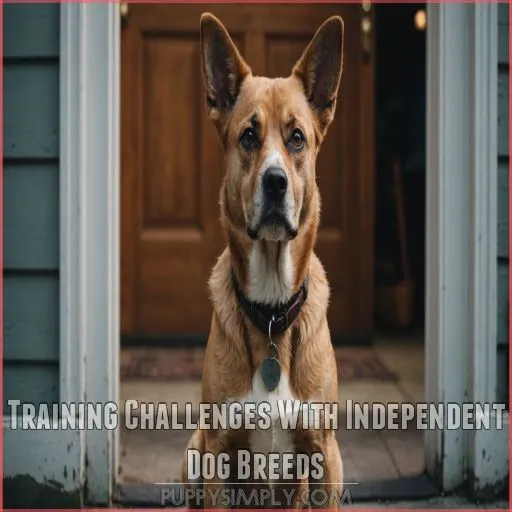This site is supported by our readers. We may earn a commission, at no cost to you, if you purchase through links.

These self-reliant pups, like Basset Hounds and Chow Chows, are happy to lounge while you’re out conquering the world. They’re the roommates who don’t eat your leftovers or hog the remote.
With lower maintenance needs and adaptability to your schedule, these breeds are perfect for the solo lifestyle. But don’t be fooled – they still need love and training.
Their stubborn streak can be as strong as your coffee, so you’ll need patience and consistency. Ready to meet your perfect match?
Table Of Contents
- Key Takeaways
- Top Independent Dog Breeds for Single Owners
- Characteristics of Independent Dog Breeds
- Benefits of Independent Dogs for Single Owners
- Training Challenges With Independent Dog Breeds
- Exercise Needs of Independent Dog Breeds
- Living Arrangements for Independent Dog Breeds
- Health Considerations for Independent Dog Breeds
- Selecting the Right Independent Breed
- Building Bonds With Independent Dog Breeds
- Preparing Independent Dogs for Alone Time
- Frequently Asked Questions (FAQs)
- Are independent dogs Good Companions?
- What are the most independent dog breeds?
- Are independent dog breeds more self-sufficient?
- Are dogs bred to function alone?
- How long can independent dogs be left alone?
- Are independent dogs less affectionate with their owners?
- Can independent dogs get along with other pets?
- Do independent breeds make good guard dogs?
- Are there any hypoallergenic independent dog breeds?
- Conclusion
Key Takeaways
- You’ll find that independent breeds are like low-maintenance roommates – happy to chill while you’re out conquering the world, but still up for cuddles when you get home.
- Don’t let their solo spirit fool you – these pups still need your love and attention. Think of it as a balancing act between respecting their space and building a strong bond.
- Your living situation matters more than you might think. Whether you’re in a cozy apartment or have a sprawling backyard, there’s an independent breed that will fit right in.
- Training an independent dog can feel like herding cats, but with patience and positive reinforcement, you’ll have a well-behaved companion who keeps you on your toes.
Top Independent Dog Breeds for Single Owners
You’re busy, but you still want a furry friend?
Check out these independent dog breeds that can handle some alone time without turning your place into a disaster zone.
From laid-back Basset Hounds to self-entertaining Pugs, these pups are perfect for single owners who need a low-maintenance companion.
Basset Hound
With their droopy eyes and long ears, Basset Hounds might seem like couch potatoes, but don’t be fooled!
These independent pups have a nose for adventure. You’ll love their easygoing nature, perfect for apartment living.
While they can be stubborn, patient training pays off. Their low-key energy means they’re content to lounge while you’re out, making them ideal companions for busy single owners.
Pekingese
While Pekingese might look like royal lapdogs, they’re actually little lions in disguise. These independent pups are perfect for solo living, with their dignified demeanor and low-maintenance needs.
You’ll love their confident strut and comical bursts of playfulness. Just be prepared for some snoring serenades.
Remember, these furry emperors need consistent grooming and gentle training to keep their stubborn streak in check. They’re adaptable to small spaces and don’t require much exercise – ideal for busy singles!
American Foxhound
The American Foxhound is a true free spirit, perfect for independent souls. These hounds, once George Washington’s hunting companions, now make excellent pets for solo living. You’ll love their easy-going nature and low-maintenance grooming (Source). But beware, they’ve got a set of pipes on them!
Here’s what you need to know:
- They’re vocal virtuosos – expect a symphony of bays and howls
- Exercise is non-negotiable – an hour or two daily keeps them happy
- They’re friendly but have a strong prey drive – keep small pets at a distance
- Training can be challenging – patience is key with these independent thinkers
Pug
Pugs might surprise you as independent companions for single living. These wrinkly-faced charmers pack a big personality into a small package. You’ll find them affectionate yet stubborn, perfect for those who enjoy a balance of cuddles and me-time.
Let’s explore the pug’s quirks:
| Pug Trait | Joy Factor | Challenge Level |
|---|---|---|
| Snoring | Adorable | Sleep disruptor |
| Shedding | Constant reminders | 粒 Daily vacuuming |
| Loyalty | ❤️ Never alone | ♂️ Velcro dog |
| Wrinkles | Expressive face | 識 Regular cleaning |
Tibetan Spaniel
Moving from one small breed to another, you’ll find the Tibetan Spaniel a charming choice for solo living.
These ancient watchdogs, once perched on monastery walls, now make perfect apartment companions.
With their lion-like mane and expressive eyes, Tibbies are as adorable as they’re independent.
They’re low-maintenance in grooming and exercise, but high in affection.
Just be prepared for a little stubborn streak – it’s part of their charm!
Greyhound
Looking for a canine companion that’s as cool as a cucumber?
Meet the greyhound! These sleek sighthounds are pros at chilling out, spending most of their day napping.
You’ll love their independent streak, perfect for your single lifestyle.
Don’t let their racing history fool you – older greyhounds are couch potatoes at heart. They’re sensitive souls, so keep the drama low and the love high.
Chow Chow
While Greyhounds are couch potatoes, Chow Chows are the feline-like aristocrats of the dog world. These ancient Chinese breeds are known for their distinctive blue-black tongues and lion-like manes.
They’re perfect for independent souls who appreciate a dash of regality in their lives.
You’ll find these fluffy companions:
- Dignified as emperors (2,500 once lived with one!)
- Loyal yet aloof, like furry zen masters
- Sporting a "stilted" walk that’s pure catwalk material
- Rocking either a rough or smooth coat, for your grooming pleasure
Lhasa Apso
The lion-hearted Lhasa Apso packs a big personality into a small package.
You’ll love this independent breed’s regal dignity and watchdog instincts .
With a history stretching back to 800 A.D. , these pups are perfect for apartment living and single owners.
They’re low-maintenance in exercise needs but high-maintenance in grooming.
Their stubborn streak means you’ll need patience for training, but their loyalty and long lifespan make it worthwhile.
Characteristics of Independent Dog Breeds
Independent dog breeds are the mavericks of the canine world, and the Shikoku Dog is a prime example
. You’ll find these pups have a knack for self-reliance that’d make even a lone wolf jealous.
They’re like the cool cats of the dog universe – aloof, yet charming in their own way. Picture a Basenji, strutting around like they own the place, because in their mind, they do!
These breeds often have a rich history as working dogs, which explains their ‘I’ve got this’ attitude.
Some independent dog breeds, such as the Italian Greyhound and Chow Chow, are particularly well-suited for busy owners due to their low-maintenance needs.
They’re quick thinkers with a dash of stubbornness, perfect for those who appreciate a dog with a bit of sass. But don’t be fooled – they’re not all about the solo life. With the right socialization, these independent spirits can become your loyal sidekick, always up for an adventure but equally content doing their own thing.
Benefits of Independent Dogs for Single Owners
Living solo doesn’t mean you can’t have a furry friend – independent dog breeds offer the perfect balance of companionship and self-sufficiency, ideal for women seeking best dogs for single women
.
You’ll enjoy the perks of canine company without the stress of a needy pup, making it easier to juggle work, social life, and pet parenthood.
Low Maintenance Needs
Now, let’s talk about the icing on the cake for busy single owners: low maintenance needs.
You’ll love how these independent pups fit into your hectic life like a glove.
Grooming? A breeze.
Feeding? Simple.
Exercise? Minimal .
Take the Basset Hound, for example.
This lazy bones is content with a short walk and a long nap.
It’s like having a furry roommate who doesn’t hog the bathroom!
Adaptability to Owner’s Schedule
You’ve got a busy life, but that doesn’t mean you can’t have a furry friend.
Independent dog breeds are like chameleons, adapting to your ever-changing schedule.
Whether you’re working late, traveling, or enjoying weekend activities, these pups roll with the punches.
They’ll happily snooze while you’re out and perk up when you’re ready for playtime.
It’s like having a low-maintenance roommate who’s always excited to see you, and they will always be happy to see you after a long day of weekend activities.
Reduced Separation Anxiety
Say goodbye to guilty goodbyes!
Independent dog breeds often show fewer signs of separation anxiety, making your solo adventures stress-free. These cool cucumbers won’t turn your home into a disaster zone while you’re out.
With proper crating and desensitization training, they’ll treat your absence like a mini-vacation. Calming pheromones can help, too.
Remember, even laid-back pups like the Cavalier King Charles Spaniel need time to adjust. Your furry friend will be chillin’ like a villain in no time!
Self-entertainment Capabilities
Imagine coming home to a content pup who’s been happily entertaining themselves all day.
Independent dogs are masters of solo play, turning your home into their personal playground.
They’ll keep busy with enrichment toys, solving puzzles for treats, or simply enjoying quiet time.
These canine Einsteins can transform mealtime into a half-hour game, turning your living room into a kibble hunt adventure and can even make the most of their alone time.
They’ll keep busy and stimulated, making them a great example of canine Einsteins.
Training Challenges With Independent Dog Breeds
You might find training an independent dog feels like teaching a cat to fetch – they’ve got their own agenda.
But don’t worry, with the right tricks up your sleeve, you’ll turn that stubborn pooch into a well-behaved companion in no time, with the right approach being well-behaved companion.
Stubborn Tendencies
Stubborn tendencies can make training independent breeds feel like herding cats. These free spirits often march to their own beat, preferring to make decisions solo.
Don’t fret! With patience and consistency, you’ll crack the code. Use positive reinforcement to speak their language, and remember: their stubbornness is just independence in disguise.
Embrace their unique personality, and you’ll find a loyal companion who keeps you on your toes, and they will become a loyal companion.
Distraction-prone Behaviors
While independent dogs can be strong-willed, they’re also easily distracted.
You’ll need to up your training game to keep their attention.
Imagine this: you’re out for a stroll, and suddenly your pup’s nose is glued to every lamppost. It’s like they’ve become a four-legged detective!
Focus management is key. Start small and build up to larger distractions gradually. Remember, you’re competing with a world of exciting smells and sights.
You’ll need to be patient and adapt to their easily distracted nature, using training game techniques effectively.
Effective Positive Reinforcement Techniques
Got a distracted pup? No worries! Positive reinforcement is your secret weapon.
Treat-based training works wonders – your furry friend will be keen to please for a tasty morsel. Remember, consistency is key for success, and you’ll be the proud owner of a well-behaved pooch in no time!
Think of yourself as your dog’s personal cheerleader – pom-poms optional, but treats are definitely required!
You can also try clicker training along with praise to keep things interesting. Keep it short and sweet, as dogs don’t speak in paragraphs!
Importance of Early Socialization
Don’t let your independent pup turn into a lone wolf!
Early socialization is the secret sauce for raising a well-adjusted canine companion.
By exposing your furry friend to various experiences, people, and animals during their critical developmental period, you’re setting them up for success.
This process helps prevent fearfulness and aggression, while boosting their confidence and adaptability.
Remember, even independent breeds need social skills to thrive in our human world!
Exercise Needs of Independent Dog Breeds
You might think independent dogs don’t need much exercise, but that’s not always the case.
While some breeds are content with a quick walk, others need plenty of playtime to keep their bodies and minds sharp, so it’s essential to match your energy level with your furry friend’s needs.
Others need plenty of playtime
Low-energy Breeds
Couch potatoes, rejoice! Low-energy breeds are perfect for your laid-back lifestyle.
These pups, like the Basset Hound or Chow Chow, prefer snoozing to chasing balls .
You’ll still need to take them on short walks to keep them healthy, but they won’t run you ragged.
Even lazy dogs need some exercise and mental stimulation to prevent weight gain and boredom.
High-energy Breeds Requiring Stimulation
While some independent breeds are couch potatoes, others are firecracker furballs.
High-energy pups like Border Collies and Australian Cattle Dogs need daily adventures to stay happy. These canine rocket ships thrive on playtime ideas that’ll make you both break a sweat.
Think frisbee marathons, agility courses, or even bike rides. Without proper exercise routines, these working dog dynamos might redecorate your living room – and not in a good way!
Mental Exercise Importance
Physical exercise is just one piece of the puzzle for your independent pup. Keeping their mind sharp is equally important. Think of it as a mental gym for your furry friend!
Here are four fun ways to give your dog’s brain a workout:
- Puzzle feeders: Turn mealtime into a game
- Hide-and-seek with treats: Engage their nose and mind
- New trick training: Teach an old dog new tricks
- Rotating toys: Keep them guessing with fresh challenges
Balancing Exercise With Independence
Independent pups need a specific exercise routine that fits your lifestyle. You’ve got to strike a balance between keeping them active and respecting their solo spirit.
Here’s a quick guide to help you nail it:
| Breed Type | Exercise Needs | Solo Play Ideas |
|---|---|---|
| Low-energy | Short walks, indoor games | Food puzzles, chew toys |
| High-energy | Daily runs, dog sports | Digging pits, interactive toys |
Remember, even couch potatoes need some action to stay healthy and happy. It’s all about finding that sweet spot between sweat and snooze.
Living Arrangements for Independent Dog Breeds
You’ll need to tailor your living space to suit your independent pup’s needs, whether you’re in a cozy apartment or a house with a yard.
From choosing the right breed for your square footage to creating a comfy solo hangout spot, setting up the perfect pad for your furry friend is key to a happy life together.
Apartment-friendly Options
Living in a cozy apartment doesn’t mean you can’t have a furry friend. Many breeds thrive in smaller spaces, giving you the best of both worlds.
Here are some paw-some options for your urban nest:
- Bichon Frise: These fluffy clouds are quiet and low-shedding
- Basenji: Known as the "barkless dog," perfect for thin walls
- Shih Tzu: Small, clean, and apartment-friendly
- Greyhound: Surprisingly lazy couch potatoes
- Affenpinscher: Curious and amusing little comedians
Breeds Requiring Outdoor Space
Freedom-loving pups need room to roam! If you’ve got a yard, you’re in luck. Some breeds thrive with outdoor space to stretch their legs and burn off energy.
Let’s explore which furry friends might be your perfect match:
| Breed | Outdoor Needs |
|---|---|
| American Foxhound | Large fenced area |
| German Shepherd | Spacious yard |
| Labrador Retriever | Access to water play |
Remember, a tired dog is a happy dog. These outdoor enthusiasts will keep you active and make great companions for country living or homes with ample yard space.
Home-proofing Considerations
How do you turn your pad into a pup-friendly paradise? It’s all about seeing your home through your furry friend’s eyes (Source). Get down on all fours and scout for potential hazards. You’ll want to tackle these key areas:
- Secure dangling cords and wires – no s
Creating a Comfortable Solo Environment
Your pup’s solo space should be a canine paradise. Carve out a cozy corner with a plush bed and favorite toys.
Sprinkle in some enrichment puzzles to keep their mind sharp while you’re out. Pop on some soothing tunes to create a zen atmosphere.
Establish a routine that’ll make your independent pooch feel like the king of the castle, even when you’re away. It’s all about tailoring the environment to your furry friend’s unique personality.
Health Considerations for Independent Dog Breeds
You’ll need to keep a close eye on your independent pup’s health, even if they act like they’ve got it all figured out.
From breed-specific issues to preventive care, staying on top of your dog’s well-being is essential, especially when you’re not always around to catch those sneaky symptoms.
Common Breed-specific Health Issues
While you’re setting up your pup’s solo pad, don’t forget to bone up on their health needs.
Each breed comes with its own genetic baggage.
Great Danes, for instance, are like ticking time bombs for bloat.
Chinese Shar-Peis might give you a run for your money with their wrinkly skin issues.
And if you’re sneezing up a storm, hypoallergenic breeds like Poodles could be your ticket to sneeze-free cuddles.
Preventive Care for Solo Dogs
Beyond breed-specific health issues, preventive care for solo dogs is a game-changer. Regular veterinary check-ups can help detect early signs of disease or aging changes, as well as address common health issues like obesity.
Keep your pup in tip-top shape with regular check-ups, vaccinations, and a balanced diet that includes higher protein and omega-3 fatty acids for joint health. Don’t forget to spay or neuter your furry friend – it’s not just about preventing surprises, but also warding off certain cancers.
Remember, a healthy dog is a happy dog!
- Tail-wagging wellness check-ups
- Paw-some dental cleanings
- Heart-melting cuddles during grooming sessions
- Bone-afide nutritious meals
- Leash-pulling fun exercise routines
Monitoring Health When Away
Keeping tabs on your four-legged friend’s health while you’re away is a breeze with modern tech.
Smart collars like PetPace use AI to monitor key signs and alert you to any red flags.
For diabetic pups, continuous glucose monitors can be a game-changer, giving you a real-time picture of their blood sugar levels.
With these gadgets, you’re always in the loop, even when you’re miles apart, thanks to modern tech.
Importance of Regular Vet Check-ups
Don’t let your independent pup’s health slip through the cracks! Regular vet check-ups are your secret weapon for preventive care and early detection.
You’ll catch potential issues before they become major headaches, saving you time and money in the long run. Plus, these visits help establish a baseline for your furry friend’s health, making it easier to spot changes.
Stay on top of that vaccination schedule and keep your solo sidekick thriving with preventive care!
Selecting the Right Independent Breed
Finding the perfect pup for your solo lifestyle isn’t just about picking the cutest face at the shelter.
You’ll want to match your energy and space with a breed that’s happy to chill while you’re out conquering the world.
But still ready for cuddles and adventures when you’re home.
Assessing Your Lifestyle
You’ve got your pup’s health in check, now let’s talk about finding your perfect canine match.
Figuring out your lifestyle is like picking the right dance partner – you want someone who can keep up with your rhythm.
Consider these key factors:
- Your energy level: Are you a couch potato or a fitness fanatic?
- Home sweet home: Apartment dweller or backyard enthusiast?
- Social butterfly or lone wolf: How often do you entertain?
- Wanderlust level: Frequent traveler or homebody?
Remember, choosing a dog is a bit like online dating – it’s all about finding that perfect fit for your unique lifestyle.
Considering Work Schedule
Your work schedule plays a big role in choosing the right pup.
If you’re burning the midnight oil, consider laid-back breeds like Greyhounds or Mastiffs (Source). They’re the couch potatoes of the dog world!
For flexible hours or remote work, high-energy breeds like Golden Retrievers might be your perfect match.
Remember, even busy bees can keep their furry friends happy with quick indoor games or puzzle toys between Zoom calls.
Evaluating Living Space
Often, the perfect pup for your pad depends on more than just square footage.
Think about your living space like a doggy playground. Is it a cozy apartment or a sprawling house with a yard? Consider noise levels and safety too.
Some breeds are apartment all-stars, while others need room to roam. For instance, if you’re living in a small apartment, you may want to think about breeds that are known for being quiet, such as the Basenji, which communicates through chirps and yodels instead of barks.
Additionally, you can also look into low-maintenance breeds like the French Bulldog. Remember, even in tight quarters, you can create a tail-wagging haven with the right setup.
Matching Energy Levels
Beyond space considerations, energy levels are the heartbeat of a perfect match. Like finding your dance partner, sync your rhythm with your pup’s.
Some breeds are couch potatoes, while others are furry fireballs.
Consider:
- Your daily routine and exercise habits
- The breed’s activity needs
- Your capacity for playtime and walks
Remember, a bored dog can turn your home into a doggy disaster zone faster than you can say "fetch!
Building Bonds With Independent Dog Breeds
You might think independent dogs are aloof, but they’re just waiting for you to speak their language.
With the right approach, you’ll build a bond that’s as strong as it’s unique, balancing their need for space with your desire for companionship.
Quality Time Strategies
Carving out quality time with your independent pup doesn’t have to be a tall order.
Mix up your routine with interactive play sessions that challenge their problem-solving skills. Squeeze in quick training bouts throughout the day to keep their minds sharp.
Take mindful walks, letting them explore at their own pace. For solo adventures, try scent work or agility courses.
These bonding activities will strengthen your connection while respecting their independent streak.
Respecting Their Space
How do you build a bond with your independent pup while respecting their space? It’s all about finding that sweet spot between affection and autonomy.
Your furry friend needs their own safe haven . This is especially true for breeds that were originally bred for guarding and protection, such as the German Shepherd and Rottweiler, which have a strong instinct to defend their territory and family Protective Instincts in Guard Dogs.
By understanding and respecting this natural behavior, you can create a harmonious and trusting relationship with your independent pup. Here’s how to strike the right balance:
- Create a cozy "no-go zone" for your dog
- Let them initiate playtime on their terms
- Learn to read their body language and respect when they need alone time, especially for breeds like Beagles that can suffer from separation anxiety if left alone for extended periods understanding beagle alone time
Remember, respecting boundaries isn’t just polite—it’s the key to a trusting relationship.
Effective Communication Techniques
Speaking your pup’s language isn’t rocket science, but it’s the key to a rock-solid bond. You’ll want to master the art of canine communication like a pro.
Let’s break it down:
| Technique | Description |
|---|---|
| Body Talk | Read those tail wags and ear positions |
| Vocal Cues | Use consistent commands with a confident tone |
| Positive Vibes | Reward good behavior with treats or praise |
Remember, patience is your secret weapon. With practice, you’ll be chatting with your furry friend like old pals in no time!
Balancing Affection and Independence
You’ve mastered the art of canine communication, but now it’s time to strike a balance between cuddles and independence.
Like a tightrope walker, you’ll need finesse to navigate this delicate act.
Here’s your game plan:
- Respect boundaries: Give your furry friend their own "me time"
- Build trust through positive reinforcement: Reward good behavior, not just affection
- Enrich solo time: Provide puzzles and toys for mental stimulation [citation
Preparing Independent Dogs for Alone Time
You’ve got your independent pup, but now it’s time to prep them for solo adventures.
Let’s explore how to set up your furry friend for success when you’re not around, from creating a cozy den to mastering the art of distraction with puzzle toys, like puzzle toys.
Creating a Safe Space
While you’re away, your independent pup needs a cozy den to call their own.
Transform a corner of your home into a safe haven with a comfy bed, favorite toys, and perhaps a crate for added security. Think of it as their personal "pawlace" – a spot where they can relax without a care in the world.
Enriching the space with puzzle toys can keep their minds engaged, reducing anxiety and making alone time a breeze, and creating a place for "separation anxiety relief" managing dog separation anxiety and "added security
.
Establishing a Routine
Now that you’ve created a cozy den for your furry friend, let’s set the stage for some solo superstar moments.
Imagine this: you’re the director, and your pup’s the lead in "A Day in the Life of an Independent Pooch."
Craft a predictable daily script with feeding schedules, walk times, and playtime.
Mix in crate training for peaceful meals and cool-down spots.
Remember, consistency is key – it’s the secret sauce for a confident canine.
Gradual Alone-time Training
Your routine’s set, but your pup’s still glued to your hip? Time to teach them the art of flying solo!
Start small – leave Fido alone for just five minutes. Gradually increase the time, rewarding calm behavior with treats and praise.
It’s like teaching a toddler to nap – patience is key. Remember, crate training can be a lifesaver for battling separation anxiety.
Your independent pooch is just a few positive reinforcement sessions away!
Using Interactive Toys and Puzzles
Interactive toys and puzzles are your secret weapons for keeping your furry friend entertained while you’re away.
These mental gymnastics for dogs can work wonders:
- Treat-dispensing puzzles to challenge their problem-solving skills
- Squeaky toys for auditory stimulation
- Snuffle mats to engage their natural foraging instincts
Mix up the difficulty levels to keep your pup on their toes. Remember, a mentally stimulated dog is a happy dog – and less likely to redecorate your living room!
Frequently Asked Questions (FAQs)
Are independent dogs Good Companions?
Picture a lone wolf, fiercely independent yet loyal to its pack.
Independent dogs can be excellent companions, offering affection while respecting your space.
They’re smart, adaptable, and perfect for those who value autonomy in their relationships, making them excellent companions .
What are the most independent dog breeds?
Looking for a furry friend who won’t demand constant attention?
Consider these independent breeds: Chow Chows, Basenjis, and Shar-Peis.
They’re like the introverts of the dog world – happy to chill while you’re out living your best life.
Are independent dog breeds more self-sufficient?
Did you know 25% of dogs can handle being alone?
Independent breeds are indeed more self-sufficient. They’ll entertain themselves and won’t cling like a shadow.
You’ll appreciate their ability to fly solo when you’re busy.
Are dogs bred to function alone?
Dogs aren’t typically bred to function alone.
They’re social animals, often needing companionship.
Some breeds, like livestock guardians, can work independently, but they still require training and supervision, especially as puppies.
It’s not a one-size-fits-all scenario.
How long can independent dogs be left alone?
You can leave adult dogs alone for 4-6 hours typically, with some adapting to 8 hours if necessary.
They’re social creatures craving your company.
Provide engaging toys and consider doggy daycare for longer absences.
Are independent dogs less affectionate with their owners?
Independent pooches aren’t necessarily less loving; they just show it differently.
While they may not be lap dogs, they’ll still greet you at the door and form strong bonds.
It’s about understanding their unique love language .
Can independent dogs get along with other pets?
With early socialization and training, even independent pooches can become pals with other pets.
It’s like teaching an old dog new tricks – patience is key.
Start young, and you’ll see tails wagging in no time.
Do independent breeds make good guard dogs?
It’s a double-edged sword.
Independent breeds can make excellent guard dogs, combining natural protective instincts with a watchful nature.
They’re often fearless and loyal, but require proper training to channel their strength and size effectively, which can make them fearless and loyal companions.
Are there any hypoallergenic independent dog breeds?
Yes, you’ve got options! Poodles, Schnauzers, and Bichon Frises are hypoallergenic and independent.
These low-shedding breeds won’t keep you sneezing or tied down.
Bonus: they’re smart cookies, perfect for your free-spirit lifestyle. Choose wisely, and breathe easy!
Conclusion
Embracing independent dog breeds for single owners isn’t just about finding a low-maintenance pet—it’s about discovering a fur-ever friend who vibes with your solo lifestyle.
These canine companions offer the perfect balance of affection and autonomy, giving you the freedom to live your best life while still enjoying the perks of dog ownership.
Remember, even the most independent pups need your love and attention. So, whether you’re chilling with a Chow Chow or lounging with a Lhasa Apso, you’re in for a tail-wagging good time.
Ready to meet your solo lifestyle match and find your ideal canine companions?
















